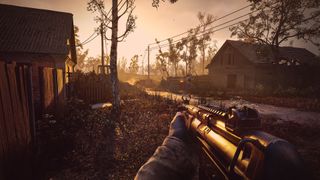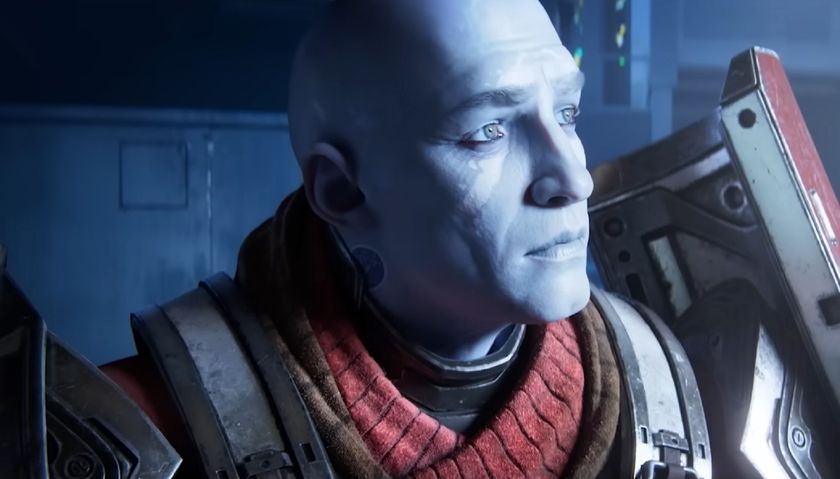Stalker 2's massive open world is built to explore for "as long as you can survive", and it may be the secret weapon that wins over Fallout, Metro, and The Last of Us fans
GSC Game World's Zakhar Bocharov joins us for a dive into The Zone and its brutal take on exploration

When I sat down to play three hours of Stalker 2: Heart of Chornobyl, the game's sheer openness caught me unawares. After a brief introduction, you're dropped into The Zone and set loose, free to start hoovering up side quests or scavenging for gear. Exploring The Zone is driven through equal parts curiosity and practicalness – yes, that ominous cave looks tantalizing, but do you have enough bullets to face whatever inevitably calls it home?
It's a far cry from the original Stalker trilogy, which focused on narrower slices of The Zone, which by their slimmer nature, played a stricter role in guiding your journey. Though Stalker 2's difficulty and scrappy shootouts makes it unlike any post-apocalyptic game around, it's easy to see its expanded open world offering more common ground for, say, Fallout fans to find their way in through. Even the likes of Metro and The Last of Us have flourished in the 15-year gap between the last Stalker and Stalker 2, meaning now feels like the perfect opportunity to open the series to new fans.
Stalker 2: Shadow Of Chornobyl – The Big Preview
This month, we're all about Stalker. Tag along for our deep-dive – which includes a three-hours hands-on with the game itself – at our Stalker 2: Heart of Chornobyl Big Preview hub.
Post-post apocalypse


Check out our Stalker 2 preview to see what we made of three hours in The Zone
Speaking to 12DOVE, GSC Game World's PR lead Zakhar Bocharov says that the way to do that is through The Zone. "Personally, I really enjoy the way Chornobyl is recreated in this game," says Bocharov. "It clicks for me [through] absolutely random moments – being somewhere and it's sunset, and there's some sort of sign over there, hanging, and there is music playing in the distance, and the grass waves in the wind, and there's an anomaly and footsteps. It's about the atmosphere, it just clicks – it resonates – with you."
Bocharov says it's hard to pinpoint exactly what "clicks with you" in other post-apocalyptic games, which means newcomers may get into Stalker for completely different reasons. "For some it will be enjoying the gunplay, or the freedom," he explains. "For some people, obviously, it will be way too difficult [...] We'll have a story mode, but it can be like this! But for those who it clicks with, I think it'll be for the atmosphere."
Having spent most of my Stalker 2 preview aimlessly wandering The Zone, it's hard to argue with that assessment. There's something special about picking through somewhere so openly hostile, appreciating the beauty of rural Ukraine whilst vigilantly looking for the next bandit, anomaly, or mutant that wants you dead. From a practical standpoint, The Zone feels equally busy. The first town I visit, a community of stalkers and occupying Warden soldiers, is dense with things to do, from taking odd jobs from the bartender to wading into inter-factional politics. It's chunkier than anything I've seen in the past trilogy, and although I assumed this would be The Zone's central hub, Bocharov bursts my bubble. "It's just one of them," he says, grinning. "I don't think that's the biggest hub, sorry!"

It's a bold claim, given how packed that first town feels. Out of curiosity, I zoomed out on Stalker 2's map as far as it could go, and was so surprised by how big it seemed. I had to confirm with Bocharov that it was all playable space. It is, he says, but actually exploring it all is another matter entirely. Though you're able to access it all from a certain point in the game, Bocharov explains that it's "difficult" because players will need to manage their conditions and resources for long trips, which will require stopping in at various hubs along the way. "It's a level of freedom that you can explore yourself, as long as you can survive in this world of hard rules," he says.
Bocharov – who admits he tends to stick to the main story and side quests he finds along the way – "genuinely has no estimate" on how long it would take to cross one side The Zone to the other, but jokes that some dedicated players will probably find out within hours of launch. "It's a really big map," he says. "There is no transport. A lot of things need to be covered by food. All fast-traveling is based on money, so it's closer to a cooperative system, where you actually need to pay someone to guide you to another part of The Zone."
Sign up to the 12DOVE Newsletter
Weekly digests, tales from the communities you love, and more
As Bocharov alluded to, I don't think this style of exploration will be for everyone. Just look at Dragon's Dogma 2, which launched earlier this year to a fanbase divided by its restrictive fast-traveling options, which were limited to hiring a wagon or using (initially very scarce) crystals to get between cities. I loved it, in the same way I enjoy puttering around The Commonwealth in Fallout 4's survival mode, or outright refusing to fast-travel in Red Dead Redemption 2 in favor of clip-clopping along every scenic route available.
Ultimately, I think this encapsulates what will make or break Stalker 2 for a lot of prospective fans. It's immersion at all costs, regardless of whether that makes things awkward – sometimes even frustrating – at times. Personally, I can't wait to become The Zone's biggest tourist, plotting out elaborate journeys and adventures for a chance at coming away from them with a new story to tell. It's also fair to assume that some players won't enjoy meticulously walking around a field of anomalies, rather than just warping to their objective on the map. And that's fine – each to their own! But if the rest of this map is anything like the segment I've explored, I sincerely hope The Zone can awaken more Stalker sickos when it launches on November 20.

Andy Brown is the Features Editor of Gamesradar+, and joined the site in June 2024. Before arriving here, Andy earned a degree in Journalism and wrote about games and music at NME, all while trying (and failing) to hide a crippling obsession with strategy games. When he’s not bossing soldiers around in Total War, Andy can usually be found cleaning up after his chaotic husky Teemo, lost in a massive RPG, or diving into the latest soulslike – and writing about it for your amusement.

Ubisoft reaches deal with Tencent to create $4.3 billion mini-Ubisoft subsidiary to "spearhead development" on new Assassin's Creed, Far Cry, and Rainbow Six games

When Destiny 2 "weekly active users dropped lower and faster than we'd seen since 2018," Bungie assembled an A-Team to put out some fires: "We needed to do something"











